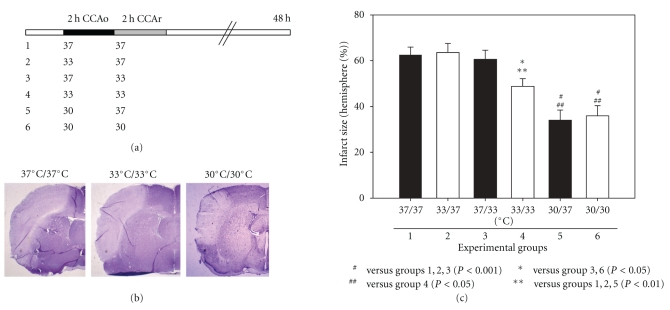Figure 3.
(Revised from [19]) (a) Protocols for surgery and temperature management. Six groups of rats were studied. The distal MCA was occluded permanently. The black portion of the bar represents bilateral CCA occlusion (CCAo) for 2 h, and the gray portion indicates 2 h of temperature management after CCA release (CCAr), including 30°C, 33°C, and 37°C. Rats were allowed to survive for 48 h after stroke. (b) Photographs of representative infarct sections after cerebral ischemia from groups 1, 4, and 6. Permanent distal MCA occlusion plus 2 h of bilateral CCA occlusion caused an infarct in the ipsilateral cortex of the occluded MCA (left, group 1). A coronal section from Level 2 is presented. Four hours of mild hypothermia (center, group 4) mildly decreased infarct size. When the temperature was reduced to 30°C robust protection was observed (right, group 6). (c) Bar graph showing that hypothermia reduces infarct size after stroke only under certain conditions. A mean infarct size for each group was calculated as the sum of all 4 levels for each animal divided by the number of animals in each group. The infarct size did not differ among groups 1 through 3. However, the infarct in group 4 was reduced about 22% relative to group 1. When the temperature was decreased to 30°C (group 5) robust protection was observed; an additional 2 h of hypothermia in group 6 did not further reduce infarct size.

